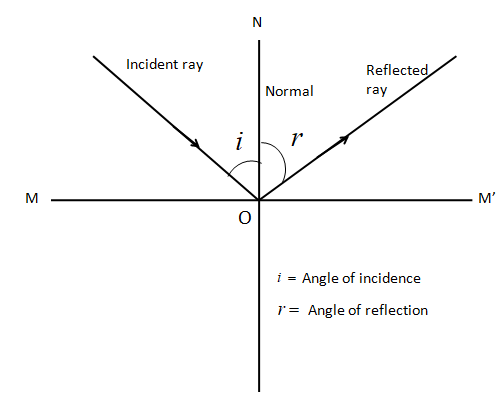
Angle of incidence is the angle between ______ and the _______.
Answer
463.8k+ views
Hint: Light’s behavior can be predicted easily. If a light ray is coming towards a flat mirror, then the behavior of the light would follow the law of reflection. To understand what is meant by the angle of incidence we need to know about the concept of reflection light. When light rays hit the surface of the mirror or any other smooth surface it reflects.
Complete Step By Step Answer:
The angle of incidence can be defined as the angle between the incident ray of the incoming light ray and the line perpendicular to the surface at the point of incidence. This point is called the normal. The angle of incidence is shown below in the diagram.

Therefore the angle of incidence can be defined as the angle formed between the incident ray and the normal line drawn normal to the point of incidence.
Additional Information:
The law of reflection governs the behavior of light such as the reflection of light rays hitting smooth surfaces, such as glass mirrors that are metal coated or polished metal. The law of reflection states that on reflection from the smooth surface, the angle of the reflected ray will be equal to the angle of the incident ray.

The ray of light that is incident on the plane surface or smooth surface is called the incident ray. The ray that tends to reflect is called the reflected ray. The point where incident light hits the surface is called the point of incidence. If we draw a line perpendicular to this point it is called normal.
Note:
Similar to reflection there is another phenomenon of light which is known as refraction. This happens when the light passes from one medium to another medium of different densities. The angle of incidence and the angle of refraction have a relationship and this relationship is explained by Snell’s law.
Complete Step By Step Answer:
The angle of incidence can be defined as the angle between the incident ray of the incoming light ray and the line perpendicular to the surface at the point of incidence. This point is called the normal. The angle of incidence is shown below in the diagram.

Therefore the angle of incidence can be defined as the angle formed between the incident ray and the normal line drawn normal to the point of incidence.
Additional Information:
The law of reflection governs the behavior of light such as the reflection of light rays hitting smooth surfaces, such as glass mirrors that are metal coated or polished metal. The law of reflection states that on reflection from the smooth surface, the angle of the reflected ray will be equal to the angle of the incident ray.

The ray of light that is incident on the plane surface or smooth surface is called the incident ray. The ray that tends to reflect is called the reflected ray. The point where incident light hits the surface is called the point of incidence. If we draw a line perpendicular to this point it is called normal.
Note:
Similar to reflection there is another phenomenon of light which is known as refraction. This happens when the light passes from one medium to another medium of different densities. The angle of incidence and the angle of refraction have a relationship and this relationship is explained by Snell’s law.
Recently Updated Pages
Master Class 12 Business Studies: Engaging Questions & Answers for Success

Master Class 12 Economics: Engaging Questions & Answers for Success

Master Class 12 English: Engaging Questions & Answers for Success

Master Class 12 Maths: Engaging Questions & Answers for Success

Master Class 12 Social Science: Engaging Questions & Answers for Success

Master Class 12 Chemistry: Engaging Questions & Answers for Success

Trending doubts
What is meant by exothermic and endothermic reactions class 11 chemistry CBSE

Which animal has three hearts class 11 biology CBSE

10 examples of friction in our daily life

One Metric ton is equal to kg A 10000 B 1000 C 100 class 11 physics CBSE

1 Quintal is equal to a 110 kg b 10 kg c 100kg d 1000 class 11 physics CBSE

Difference Between Prokaryotic Cells and Eukaryotic Cells




